Berlin: Where Bankrupt East Meets Bankrupt West
  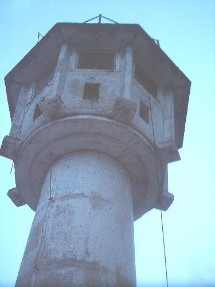 Berlin Then, Berlin Now History has been Berlin's biggest industry for centuries, and that's the only thing about it that hasn't changed today. The city has been the parade-ground nerve center of militaristic Prussia, the crown of imperial Germany, the hedonistic capital of the doomed Weimar Republic, the seat of Nazi rule, and the flashpoint of the Cold War and site of the most infamous wall ever built. Allow the following Wall Documentary 5-15 seconds to load ... *The Wall Video 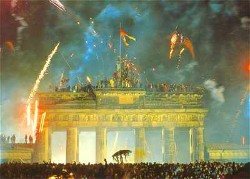 Today it's the beating heart of reunified Germany, the government's headquarters and recipient of countless millions in investment. November 2004 Reunification has proved to be more costly and complicated than expected. In April, a government commission concluded that the estimated $1.5 trillion spent so far to merge the two economies has been an "unmitigated disaster," with most of the money wasted on inefficient subsidies for the east. While nobody predicts a national divorce, enthusiasm for the new Germany is clearly ebbing. In September, an opinion survey conducted by the Forsa research institute found that a quarter of west Germans wished there was a way to bring back the wall. At the same time, one in 12 east Germans said they wanted their old country back. Unemployment in their part of the country is roughly twice the level in the west. June 2003 The anti-social policies of the SPD/PDS (Social Democratic Party/Party of Democratic Socialism) coalition in the Berlin Senate are becoming more and more pronounced. While the Berlin Banking Corporation, having narrowly escaped bankruptcy, expects to be able to balance its books in the near future thanks to generous subsidies from the Senate, it is increasingly clear that the capital’s public finances are being forced into insolvency. The working population of Berlin will be saddled with a preposterously large bill for years to come. June 2001 For ten years Berlin, which according to the German constitution is a state as well as the capital city of Germany, has been governed by a coalition consisting of the SPD (Social Democratic Party) and the conservative CDU (Christian Democratic Union). Now, after a long period of public acrimony, the Berlin SPD has announced its decision to quit the coalition, making new elections inevitable. The plan by SPD leaders to quit the coalition must be ratified by a special conference of the SPD, to be held June 10.  references ... *Berlin coalition government breaks up *In Berlin Wall's Dust, Germany Flounders *Berlin population to pay for bank bailout  Berlin Cultural Scene Bankruptcy The Berlin Symphonic Orchestra can look back on fifty exciting and successful years. What is going to happen now that the city of Berlin is on the verge of bankruptcy? In times when money is tight politicians do of course start to ask whether Berlin will be able to afford five concert orchestras and three opera orchestras, which also hold concerts, in the long term. Do we, a journalist recently asked, actually bake and eat fewer rolls than during the time of the Berlin Wall? In the first place, a wealth of artistic offerings becomes all the more necessary, the more unstable the social fabric is, and in the second place, Berlin's reputation as a musical city should not be jeopardised, because that is one of its most attractive aspects.  reference ... *50 years Berlin Symphonic Orchestra The current cuts come as part of a long series of funding cuts that have been affecting independent Berlin culture for the last ten years. A lot of frustration has already been spent on this process, and the situation this spring is amplified by a big banking scandal and the realisation that the city is more or less bankrupt. Feelings are of course mixed, and what angers us is that the amounts saved by cuts in the cultural sector are negligeable in the bigger picture, and yet they are sufficient to destroy decade-old, successful structures. For years, Berlin's near-bankruptcy raised the constant threat of the elimination of one of Berlin's three opera houses, an extravagant number for any one city, regardless of size.  In only a few short years, it became clear that the city government simply could not sustain three companies, each with its own orchestra, core ensemble, adult and children's chorus, ballet, technical staff and construction facilities. While debate has raged as to which of the three should get the ax, each house has mounted an equally rigorous effort to secure major corporate sponsors to enhance prestige and lessen budgetary pressure. In accordance to a current "stay of execution" scheme, the ballet companies of the Staatsoper and Deutsche Oper have merged, while the Komische Oper's innovative modern company, the Berlin Ballett, has been dissolved completely. The K.O. has also all but eliminated its platform for young artists and directors, the Studio Series, and, in an effort to bulk up its ever-thinning public, gone through four different marketing directors in eighteen months.  references ... *Berlin Cultural Cuts *Klassik In Berlin  Airport Bankruptcy It is undoubtedly Europe's most eccentric airport. It boasts its own transvestite revue show, a tank full of edible carp, and a history that few of its rivals can match. But time finally seems to have caught up with Tempelhof, the lifeline to West Berlin during the airlift of 1948-49, but now scheduled for closure. The terminal building is virtually empty - queues at Tempelhof airport are unheard of. It is vast - when it was finished in 1941, it was considered to be the second largest building in the world. It was supposed to handle around six million passengers a year. But now, with Berlin City Council facing bankruptcy, the state authorities say they do not have enough money to keep the airport open. reference ... *Berlin's Eccentric Airport Faces Closure *Berlin's forgotten airport nears last flight Church Looming Bankruptcy The Catholic Archdiocese of Berlin is on the brink of financial collapse, and extensive layoffs look certain as it struggles with massive debt, a spokesman said on Monday. Many businesses have gone bankrupt in the current German slump, but Cardinal Georg Sterzinsky is one of the most unusual chief executives to be caught in the crunch. The Archdiocese is home to 382,000 Catholics. reference ... *Archdiocese of Berlin challenged by prospect of bankruptcy  reference ... *Berlin Today *Old Berlin Photos 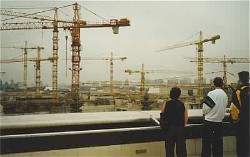 For most of the predominantly west German politicians who govern from Berlin, German reunification is less a source of national pride than tangible evidence of near-catastrophic economic failure, and a constant reminder of a problem that stubbornly refuses to go away.  The "blossoming landscapes" that Helmut Kohl, Germany's former "Unification Chancellor", promised east Germans back in 1990 have failed to materialise.  In the years since the fall of the Wall, much of east Germany has become a sort of depopulated rump state where only 40 per cent of the 15 million inhabitants work, and which has become dependent on annual injections of EUR90bn from the West for survival. 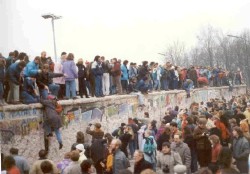 Audio: Old World Bankruptcy Tapes .... *Berlin Bankruptcy By Subsidy *Bankruptcy By Ecology *Bankruptcy By Terrorism  Old East German Communist Party Now Re-Assembled In Unified Berlin  Over 1,000 crosses adorned with the names of those murdered attempting to escape Communist East Germany for freedom during the Cold War, was to be razed in the middle of the night at 4:01 AM on July 4th Berlin time.   On the night of August 13, 1961, while East and West Berliners slept, the East German military erected a temporary structure that halted the flow of people between the two sides of the city. Once the construction of the 100-mile-long Berlin Wall was completed, anyone attempting to cross from East to West risked being shot on sight.  Subway routes stopped abruptly underneath the border; guard towers rose ominously over the barren no man's land that stretched between the two main structures of the Wall.  Families were separated with no visitation rights, and some West Berliners born in what was now East Germany would not cross a terrestrial border for fear of being detained as an East German-born citizen.  To enter East Berlin, visitors had to go through complex border-crossing procedures, including the exchange of a fixed sum of money into East German currency and sometimes the unexplained retention of passports or other kinds of harassment.  December 8, 1987 President Ronald Reagan and Soviet General Secretary Mikhail Gorbachev sign the Intermediate-Range Nuclear Forces Treaty (INF Treaty, eliminating an entire class of nuclear weapons.  reference ... *Videos:1961 Berliners Wake To Divided City  Total length of the Berlin Wall was 96 miles 27 miles went through the center of the city 23 miles went through residential areas.  66 miles were a concrete barrier 13 feet high. It had 302 watch towers and 20 bunkers. Over 5,000 people successfully crossed the Berlin Wall to freedom.  reference ... *Berlin During the Wall  Commemorating people who tried to escape to West Berlin through the wall which was there from 1961 until 1989 and were shot to death by East German guards, close to Brandenburg Gate.  President John F. Kennedy stands on a platform looking over the Berlin Wall into the Eastern sector on the day of his famous "I am a Berliner" speech.  So now instead of bulldozing the site at 4:01 AM on July 4th, the monument will be razed at 4:01 AM on July 5th. (Yes, the authorities wanted to remove the monument at a minute past 4 in the morning so that no one would notice.)  The irony of this? At 4:01 AM Berlin time on the 5th, it will still be July 4th in the USA! It will be 10 PM in New York and 7 PM in LA, just about the time Americans will be setting off fireworks to celebrate the anniversary of their independence! As the Wall Came Down the Same Communists Came Back Up  A man hammers away at the Berlin Wall on Nov. 12, 1989, as the border barrier between East and West Germany is torn down after 28 years, symbolically ending the Cold War. TWELVE years after Berliners thought they had seen the last of Communist rule, the successor to the former East German Marxist party took power in the capital amid angry protests ... reference ... *Communist Party takes back power in Berlin  Old East German Communist Party Now Re-Assembled In Unified Berlin Berlin's Socialist-Communist City Government Massive Conflict of Interest What makes this story all the more disturbing is the obvious conflict of interest involved. The Communist PDS is currently a member of the coalition that governs the city of Berlin. But prior to 1990, the PDS was known as the SED, the party that ruled East Germany with an absolutist iron fist.  Soviet soldiers hoist the red flag over the Reichstag in Berlin on April 30, 1945.  A U.S. Air Force C-54 "Skymaster" coming in to land at Berlin's Templehoff Air Base is watched by a group of blockaded Berliners in 1948.  The airlift was in operation for 15 months after the Soviet authorities halted all water and road traffic into the city on June 26, 1948.  West Berlin police hold back crowds of Germans coming from East Berlin for food and clothing in 1953.  A defecting East German soldier, Conrad Schuman, leaps over a barbed wire barricade into West Berlin on August 15, 1961. Schuman made his break for freedom to join his family, which had fled earlier to West Berlin. The barbed wire barricade would soon evolve into a concrete wall, and eventually an elaborate series of walls and fences.  Backed up by barbed wire and tank barriers, an East German police officer stands guard while a bricklayer repairs damage to the Berlin Wall near Bernauer Strasse May 26, 1962. The wall was damaged by several explosions overnight. 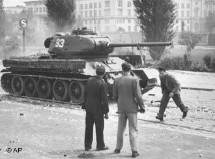 On June 17, 1953, East German workers took to the streets to protest against hardships instigated by the communist regime. The uprising was crushed by Soviet tanks, but it set the stage for peaceful protests of 1989. 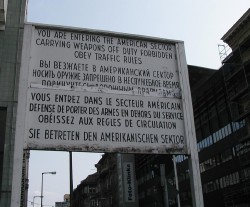 Berlin Demolishes Cold War Memorial on July 4. Monument at Historic Checkpoint Charlie To Be Removed by Court Order BERLIN, June 24, 2005 - On Monday July 4, 2005 at 4:01 a.m. a demolition crew will arrive at the site of Checkpoint Charlie to remove a memorial erected to the victims of the Cold War division of Berlin and Communist oppression of East Germany.  The monument privately financed by the Checkpoint Charlie Museum, adjacent to the site, has been in the crosshairs of those in Berlin who oppose the museum's efforts. Though the site has proven extremely popular with visitors to the city, attracting thousands of visitors per week, it has proven unpopular with Berlin's political establishment.  Currently dominated by a coalition of the former Communist Party and the Social Democratic Party, the Berlin government has refused to support the effort though supporting dozens of other less significant historic sites across the city. Local politicians did not do anything to fulfill their promise to make at least part of this land a memorial." stated Alexandra Hildebrandt, Director of the Checkpoint Charlie Museum and widow of the Museum's founder.  The Checkpoint Charlie monument scheduled for destruction July 4th in Berlin: Each cross has the name, and in some cases, photo of a victim of Communism murdered attempting to escape East Germany during the Cold War.  It was the SED dictatorship that was directly responsible for the hundreds of murders that the crosses at Checkpoint Charlie memorialize. And guess what? The PDS wants the monument torn down! To justify their decision, both members of the SPD and PDS have described the Checkpoint Charlie monument as an eye-sore or as something that trivializes the Cold War by turning the city into a Disneyland-style theme park.  (How solemn rows of crosses with the names and faces of those murdered by the SED government could possibly make any place seem like Disneyland is something that perhaps only members of Germany's Left can truly comprehend.) According to Deutsche Welle ...  references ... *Germany to bulldoze Checkpoint Charlie museum on 4th of July *Checkpoint Charley *Berlin Demolishes Cold War Memorial on July 4 Part 2  Excerpts from Larouche Seminar In Berlin ... Sovereign Nations Must Put Collapsed Global Financial System Into Bankruptcy! So over the period of the past 35 years, there have been a succession of changes in the way the world thinks about economy. And political parties, politicians and bankers, and so forth have played a key part in this, in telling people to “look at the figures--look at the financial figures.” The reliance on finance and accounting to the detriment of considering and comparing physical results, has resulted in a condition that today in the United States, we have an insane man--and I say that advisedly, as Americans are permitted to say things about Americans that Europeans are not supposed to say, but I can tell the truth about the United States as an American political figure. We are insane. We have Greenspan, the Federal Reserve Chairman, who is not only abysmally immoral, personally, but insane. |








































